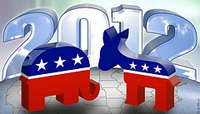 Election time is upon us and the news media is full of campaign issues. As children observe all that is happening with the omnipresent and various campaigns around the country, teachers who are looking for good books to help children understand the election process will find some new titles in this week’s selections from the International Reading Association's Children’s Literature and Reading Special Interest Group. Teachers will appreciate the article in “Social Studies and the Young Learner” (September/October 2012) entitled “We Elect a President: Using Literature to Teach Decision-Making Skills.” (Obenchain and Pennington) ReadWriteThink offers the following lesson ideas about elections:
Election time is upon us and the news media is full of campaign issues. As children observe all that is happening with the omnipresent and various campaigns around the country, teachers who are looking for good books to help children understand the election process will find some new titles in this week’s selections from the International Reading Association's Children’s Literature and Reading Special Interest Group. Teachers will appreciate the article in “Social Studies and the Young Learner” (September/October 2012) entitled “We Elect a President: Using Literature to Teach Decision-Making Skills.” (Obenchain and Pennington) ReadWriteThink offers the following lesson ideas about elections:
- November 6 is Election Day. Grades 3-12
- All About Elections. Grades K-5
- Voting! What’s It All About? Grades 3-5
- Propaganda Techniques in Literature and Online Political Ads. Grades 9-12
Also check out the Engage blog for "5 Questions with...Laurie Caulkhovan" who wrote I Grew Up to Be President (Scholastic, 2011) and "Putting Books to Work" featuring Rick Walton's I Need My Own Country (Bloomsbury USA, 2012).
GRADES K-3
Barnes, Peter and Cheryl Shaw Barnes. (2012). Woodrow for president: a tail of voting, campaigns, and elections. Washington, D.C.: Little Patriot Press.
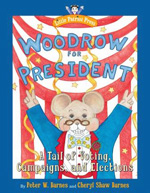
In rhymed text and mouse puns and humor, the author uses simple language for young readers to learn about the process of campaigns and elections through the career of Woodrow G. Washingtail. As a young mouse, he decides to run for the position of mayor in his town. This is just the beginning of his political career as he then goes on to run for state senator, governor, and finally the “Big Cheese.” Simplistic watercolor illustrations depict Woodrow’s campaign trail. This book does not have detailed information about the election process but will give primary children a first glimpse at how candidates move up the ranks within the political arena. The publisher’s website offers a plethora of ideas to use with the book.
- Karen Hildebrand, Ohio Library and Reading Consultant
Bruel, Nick. (2012). Bad Kitty for president. New York: Roaring Brook Press/ Macmillan.
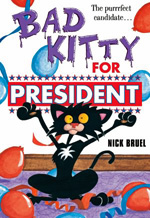
Kitty is fed up with all the strays in the neighborhood, which gives her the impetus to run for President of The Neighborhood Cat Coalition. She is especially delighted to learn how much power comes with the office. Old Kitty has been president for two terms and his tenure is up, so the timing is perfect for Kitty. With Nick Bruel’s signature humor from his previous Kitty books, and his splash of colored cartoon-like illustrations, young readers will enjoy watching Kitty embark on her campaign. The author has actually done a fact-filled job of explaining the election process including registering to vote, debating, and having a primary election. However, as Election Day is here readers will be surprised at who forgot to get registered to vote and Old Kitty’s absentee ballot may be the deciding vote! Teachers: check out the book trailer and downloadable extras at the Bad Kitty website, and read this Reading Today Online interview with Nick Bruel.
- Karen Hildebrand, Ohio Library and Reading Consultant
Clanton, Ben. (2012). Vote for me! Toronto, ON Canada: Kids Can Press.
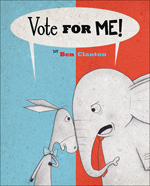
During this last month, in the United States, we have been bombarded with political phone calls and political fliers in the mail. This funny picture book notes the craziness that leads up to an election where political candidates try to get our vote. Illustrated in patriotic colors with speech bubbles, Donkey and Elephant shout, “Vote for ME!” (unpaginated). Each animal shares why we should vote for them–either because they have a high rating in the polls or they are super cute. The other animal sarcastically remarks why we shouldn’t vote for their opponent. A tiny asterisk notes humorous statistics at the bottom of the page. Just like all political candidates, Donkey and Elephant state promises they probably will not be able to accomplish. The animals banter back and forth finding fault with each other, slinging insults. An astute reader or listener will notice small illustrations at the bottom of some of the pages introducing another character. A surprise ending closes the book. This would make a perfect read aloud for children to discuss elections—either within a school for student council and/or political offices. Teachers might like to introduce the book with the book trailer located at Vimeo or learn the back matter from the author at the Two Writing Teachers blog.
- Deanna Day, Washington State University Vancouver
Englar, Mary. (2012). An illustrated timeline of U.S. presidents. Illus. by Len Epstein. Minneapolis, MN: Picture Window Books/Capstone.
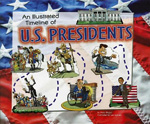
Just exactly as the title indicates, this book is a beginner’s look at the chronology of the presidents of the United States. The very basic information about each president includes their years in office, birth and death dates, political party, fast facts and important events. Colorful cartoon-like illustrations make this appropriate for primary children’s first exposure to thinking about the chain of events from one president to the next. A very well done slide show on all the Presidents is available from the White House.
- Karen Hildebrand, Ohio Library and Reading Consultant
Parish, Herman. (2012). Amelia Bedelia’s first vote. Illus. by Lynne Avril. New York: HarperCollins/Greenwillow.
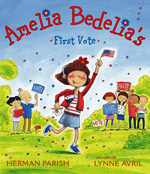
Amelia Bedelia finds it hard to slow down, especially when she’s excited, and she literally runs into the school principal, Mr. K, as she races through the hall. He agrees to consider changing some of the school policies based on the results of a classroom election in Amelia's class. Several suggestions are provided, and Amelia and her classmates are excited that they might have ice cream sandwiches or homework-free Wednesdays as the result of the election. When the vote ends in a tie, she and classmate Clay literally have a run-off on the school playground with Amelia hugging the building corners as she goes around them--literally hugging them after a classmate offers a suggestion for her to shave time off her turns around the building. It's all good fun, filled with Amelia taking everything literally, which provides plenty of chances for punning throughout the story. Amelia’s teacher Miss Edwards and Mr. K are patient and willing to take the time to talk with their students and explain the importance of voting, even on a classroom level. Perhaps if more youngsters realize the importance of one vote, they'll diligently cast their ballots during local, state, and national elections. The illustrations capture the irrepressible nature of Amelia quite well.
- Barbara A. Ward, Washington State University Pullman
GRADES 4-6
Clark, Catherine. (2012). How not to run for president. New York: Egmont.
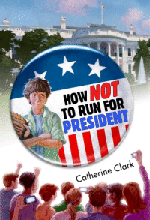
Twelve-year old middle schooler, Aidan Schroeckenbauer, has been selected to be part of an interview with the independent, third-party presidential candidate, Bettina Brandon, who is campaigning in his small Ohio town. Just as he is answering questions about more job opportunities a campaign sign swings loose and Aidan pushes Governor Brandon out of harm’s way. The press and YouTube have field day with this brave and selfless act and he gets tagged as The Clarinet Hero (since he plays in the middle school band). Ms. Brandon’s campaign advisors think it would be great publicity to invite Aidan on the campaign trail. He agrees and so begins his life in politics. The first person he needs to win over, however, is the Governor’s daughter, Emma, who is out to sabotage her mother’s election because she does NOT want to live in the White House. Eventually, Aidan and Emma become friends but young readers will get a look at what a campaign looks like on the inside. Some satire, some political jokes and lots of political jargon make this not only a fun read but also an introduction to the underside of politics. Teachers will enjoy the companion website and reading guide to go with this book.
- Karen Hildebrand, Ohio Library and Reading Consultant
Gherman, Beverly. (2012). First Mothers. Illus. by Julie Downing. Boston/New York: Houghton Mifflin Harcourt/Clarion.
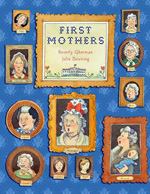
Even though today’s social studies texts highlight some of the contributions of women and there have been several titles published about the nation’s First Ladies, the role of presidential mothers has only rarely been explored in books for children. This wonderfully informative collection of stories about First Mothers provides brief biographies of the mothers of future presidents, providing insight into the women who were most influential on the nation's presidents during their formative years. Starting with Martha Ball Washington, the mother of the Father of our Country, and ending with Stanley Ann Dunham, the mother of current President Barack Obama, the book provides background information about forty-five influential women about whom history books have largely remained silent. Still, each president had a mother whose story merits at least some attention. Abe Lincoln’s parentage is represented by two entries, one for his mother and one for his stepmother. Since very little is known about some of these First Mothers, the author provides brief comments accompanied by thought or conversation balloons representing what each woman might have said. Other, better-known First Mothers merit two pages of text. The watercolor and colored pencil illustrations effectively represent each woman in clothing, dress, and demeanor. Dates of birth and death and a descriptive title are provided for each of them. Interested readers will want to check out the bibliography in the book’s back matter in order to learn even more about these women. As the presidential election looms on the horizon, this is the perfect title to stimulate interest in our nation's history and the women whose personalities helped form the nation's leaders.
- Barbara A. Ward, Washington State University Pullman
Gutman, Dan. (2012 edition). Election! A kid’s guide to picking our president. New York: Open Road Integrated Media.
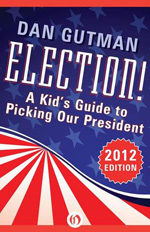
Rather than a dry book full of facts, Dan Gutman has created a practical guide to the election process using a question and answer format with over 120 questions that kids have really asked. Within the answers, he goes into the history of how our electoral process actually came into being as we know it today. He explains the Electoral College vote in a way that kids can understand. This well researched, updated edition contains the humorous slant readers are used to from earlier Dan Gutman books. This provides a great vehicle for teachers or parents to discuss politics with their children and even explain why sometimes people say nasty things about the candidates. However, Gutman takes every opportunity to encourage children to learn about the candidates, sort out the information and to become responsible civic-minded citizens and informed voters. The author’s book and others are featured on the Kid Lit and Politics blog.
- Karen Hildebrand, Ohio Library and Reading Consultant
Jackson, Carolyn. (2012). The election book: The people pick a president. New York: Scholastic.
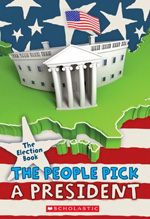
Since many Americans, young and old, have questions about how this nation elects its presidents, a reference book on elections is handy to have, especially at this time of year. In twelve short chapters, the book familiarizes readers with the process of presidential elections in the United States. It covers the roles and powers of the president as well as who can run for the nation’s highest office and provides information about campaigning for president, the conventions of political parties held to choose each party’s nominee, Election Day, the Electoral College, and even the swearing-in ceremony for each new president. The text, updated from an earlier edition, includes information on the 2008 presidential campaign and the unique fundraising efforts of President Barack Obama’s campaign team. The roles of the media, the internet, and social media are also discussed. Several terms in the books, such as bipartisanship, proportional voting, and “soft” money, require further explanation that is provided through sidebars or in the glossary. This is a good book for class group projects on elections or civic history.
- Rani Iyer, Washington State University Pullman
Sobel, Syl. (2012 edition). Presidential elections and other cool facts. Barron’s Educational Series.
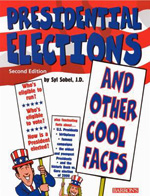
Attorney, newspaper reporter and author, Syl Sobel has created a guidebook to the presidential elections. Chapter headings include: Who will lead the country?; The rules for electing the President; The electoral college; The Presidential campaign; What if something happens to the President? This format is designed to help children understand the entire process of electing a president, especially taking time to explain the Electoral College and why and how it came into existence. The book concludes with a glossary, resource guide and index and serves as a kind of textbook approach to the presidential elections. Listen to an interview with the author at the publisher’s website.
- Karen Hildebrand, Ohio Library and Reading Consultant
Townsend, Michael. (2012). Where do presidents come from? And other presidential stuff of super great importance. New York: Penguin/Dial.
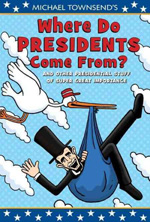
Amid the bunnies, monkeys, and general silliness about politics and presidential campaigns that fill the pages of this graphic nonfiction title, readers will find plenty of great information about the presidency, elections, the electoral process, and snippets about each of the nation's presidents and even little-known facts about the White House. The book’s six chapters insure that readers know as much as they possibly can about their own civic responsibilities and the long road that leads to the presidency and living in the White House. Because the author uses a comic strip format, he is able to provide lots of information quickly and succinctly. The information is easy to digest too since the author has taken great pains to simplify as much as possible ideas that can be confusing for political novices. A perfect choice during this presidential election year, the book would also be useful in providing background for class discussions on eligibility requirements that must be met in order to run for president, the voting process itself, campaigning for the office of president, and suffrage for women and former slaves. By the book’s final page, readers know that presidents come from just about anywhere in the United States, but they all are elected in the same way, thanks to the foresight of the nation’s leaders. Teachers may be interested in having their students send a letter to the president of the United States at this address.
- Barbara A. Ward, Washington State University Pullman
GRADES 5-8
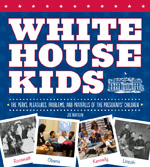 Rhatigan, Joe. (2012). White House kids: the perks, pleasures, problems and pratfalls of the Presidents’ children. Illus. by Jaemyung Shin. Imagine! Publishers.
Rhatigan, Joe. (2012). White House kids: the perks, pleasures, problems and pratfalls of the Presidents’ children. Illus. by Jaemyung Shin. Imagine! Publishers.
This scrapbook looking book will appeal to a wide range of children and adults as the author used photographs, letters, interviews, notes, and all kinds of factual tidbits to reveal what it is like to be a child in the White House. In some cases, it can be lots of fun – a bowling alley in the basement and a chef to prepare favorite foods, but there is a down side as well. Living in the fishbowl existence of publicity due to the high profile job of being a U.S. President’s child and having the press, the secret service and the paparazzi surrounding you at all times can become tiresome. The author has highlighted some of the mischief, the mysteries, and the mayhem the White House kids have been a part of while living in the nation’s capitol. The book design is inviting with sidebars, fact boxes, illustrations, and photographs. Connect this book to the website First Kids which also has lesson ideas.
- Karen Hildebrand – Ohio Library and Reading Consultant
These reviews are submitted by members of the International Reading Association's Children's Literature and Reading Special Interest Group (CL/R SIG) and are published weekly on Reading Today Online. The International Reading Association partners with the National Council of Teachers of English and Verizon Thinkfinity to produce ReadWriteThink.org, a website devoted to providing literacy instruction and interactive resources for grades K–12.